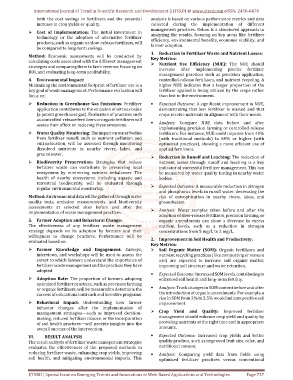Page 747 - Emerging Trends and Innovations in Web-Based Applications and Technologies
P. 747
International Journal of Trend in Scientific Research and Development (IJTSRD) @ www.ijtsrd.com eISSN: 2456-6470
both the cost savings in fertilizers and the potential analysis is based on various performance metrics and data
increase in crop yields or quality. collected during the implementation of different
management practices. Below is a structured approach to
Cost of Implementation: The initial investment in
analyzing the results, focusing on key areas like fertilizer
technology or the adoption of alternative fertilizer
efficiency, environmental benefits, economic viability, and
products, such as organic or slow-release fertilizers, will
farmer adoption.
be compared to long-term savings.
1. Reduction in Fertilizer Waste and Nutrient Losses:
Method: Economic assessments will be conducted by Key Metrics:
calculating costs associated with the different management Nutrient Use Efficiency (NUE): The NUE should
strategies and comparing them to farm revenue, focusing on increase after implementing precise fertilizer
ROI, and evaluating long-term profitability.
management practices such as precision application,
4. Environmental Impact: controlled-release fertilizers, and nutrient recycling. A
Minimizing the environmental footprint of fertilizer use is a higher NUE indicates that a larger proportion of the
key goal of waste management. Performance evaluation will fertilizer applied is being utilized by the crops rather
focus on: than lost to the environment.
Reduction in Greenhouse Gas Emissions: Fertilizer · Expected Outcome: A significant improvement in NUE,
application contributes to the emission of nitrous oxide demonstrating that less fertilizer is wasted and that
(a potent greenhouse gas). Evaluation of practices such crops receive nutrients in alignment with their needs.
as controlled-release fertilizers or organic fertilizers will ·
assess their effect on reducing these emissions. Analysis: Compare NUE data before and after
implementing precision farming or controlled-release
Water Quality Monitoring: The impact on water bodies fertilizers. For instance, NUE could improve from 40%
from fertilizer runoff, such as nutrient pollution and (with traditional methods) to 60% or higher (with
eutrophication, will be assessed through monitoring optimized practices), showing a more efficient use of
dissolved nutrients in nearby rivers, lakes, and applied fertilizers.
groundwater.
Reduction in Runoff and Leaching: The reduction of
Biodiversity Preservation: Strategies that reduce nutrient losses through runoff and leaching is a key
fertilizer waste can contribute to preserving local indicator of successful fertilizer management. This can
ecosystems by minimizing nutrient imbalances. The be measured by water quality testing in nearby water
health of nearby ecosystems, including aquatic and bodies.
terrestrial biodiversity, will be evaluated through
regular environmental monitoring. Expected Outcome: A measurable reduction in nitrogen
and phosphorus levels in runoff water, decreasing the
Method: Environmental data will be gathered through water risk of eutrophication in nearby rivers, lakes, and
quality tests, emission measurements, and biodiversity groundwater.
assessments at selected sites before and after the
implementation of waste management practices. Analysis: Water samples taken before and after the
adoption of slow-release fertilizers, precision farming, or
5. Farmer Adoption and Behavioral Change: organic amendments can show a decrease in excess
The effectiveness of any fertilizer waste management nutrient levels, such as a reduction in nitrogen
strategy depends on its adoption by farmers and their concentrations from 5 mg/L to 2 mg/L.
willingness to change practices. Performance will be 2. Improvement in Soil Health and Productivity:
evaluated based on:
Key Metrics:
Farmer Knowledge and Engagement: Surveys, Soil Organic Matter (SOM): Organic fertilizers and
interviews, and workshops will be used to assess the nutrient recycling practices (like composting or manure
extent to which farmers understand the importance of use) are expected to increase soil organic matter,
fertilizer waste management and the practices they have improving soil structure and water retention.
adopted.
· Expected Outcome: Increased SOM levels, contributing to
Adoption Rate: The proportion of farmers adopting enhanced soil health and long-term fertility.
optimized fertilizer practices, such as precision farming ·
or organic fertilizers, will be measured to determine the Analysis: Track changes in SOM content before and after
success of educational outreach and incentive programs. the introduction of organic amendments. For example, a
rise in SOM from 2% to 3.5% would indicate positive soil
Behavioral Impact: Understanding how farmer improvement.
behavior changes after the implementation of
management strategies—such as improved decision- Crop Yield and Quality: Improved fertilizer
management should enhance crop yield and quality by
making, reduced fertilizer misuse, or the incorporation
providing nutrients at the right time and in appropriate
of soil health practices—will provide insights into the
overall success of the intervention. amounts.
VI. RESULT ANALYSIS · Expected Outcome: Increased crop yields and better
The result analysis of fertilizer waste management strategies quality produce, such as improved fruit size, color, and
evaluates the effectiveness of the proposed methods in nutritional content.
reducing fertilizer waste, enhancing crop yields, improving · Analysis: Comparing yield data from fields using
soil health, and mitigating environmental impacts. This optimized fertilizer practices versus conventional
IJTSRD | Special Issue on Emerging Trends and Innovations in Web-Based Applications and Technologies Page 737

